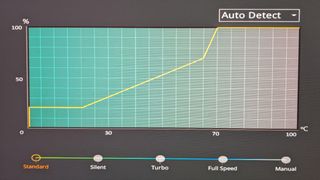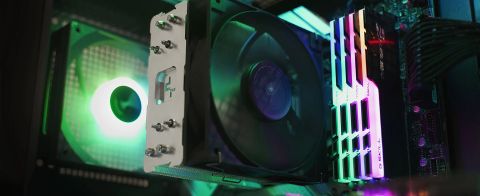Tom's Hardware Verdict
DeepCool’s AG400 offers great performance for $30 USD, handling Intel’s i9-13900K well in most workloads. But it’s best run with a fan curve, otherwise it can get a bit loud in the hottest of scenarios.
Pros
- +
Easy install (can be done with fan attached)
- +
Handles up to 250W loads with Intel’s i9-13900K
- +
Won’t get in the way of your tall RAM
Cons
- -
A bit noisier than the competition
Why you can trust Tom's Hardware
DeepCool was founded in Beijing in 1996. And the company has, in recent years, delivered some of the best CPU coolers on the market, with options like the Assassin III and AK620. DeepCool’s current lineup includes both air and AIO coolers, as well as computer cases, keyboards, power supplies, and other accessories.
We most recently reviewed DeepCool’s AK500 cooler, which performed well in our tests. Today we’re going to look at a more budget-oriented product, the single-tower AG400. With the latest CPUs from AMD and Intel requiring ever more capable cooling, is a single tower cooler enough to tame Intel’s 13900K? We’ll have to put it through testing to find out. But first, here are the AG400’s specifications from DeepCool.
Cooler Specifications

| Cooler | DeepCool AG400 BK |
| MSRP | $29.99 USD |
| Heatsink Dimensions | 120x92x150 mm |
| Weight (with fan) | 614g |
| Socket Compatibility | Intel LGA1700/1200/1151/1150/1155 |
| AMD AM4/AM5 | |
| Rated Noise Level | Up to 31.6 dBA |
| Heatpipes | (x4) 6 mm heatpipes |
| Base | Copper |
| Max TDP (Our Testing) | ~250W |
Packing and Included Contents
DeepCool’s AG400 comes in a small box, with molded foam inserts to protect the inner contents.
Included with the package are the following:


- Single-tower heatsink
- 120mm fan
- Fan clips for the included fan
- Mounts for all modern CPU sockets (including AM5 & LGA1700)
- A single-use packet of thermal paste
- Manual

Features of the AXP120-X67
Single Tower Heatsink with Matrix Fin Array
The AG400 (like the larger AK500) incorporates a matrix fin array resembling a checkerboard, which is designed to increase the static pressure of the airflow and therefore better dissipate heat. It also features four 6mm direct-contact copper heatpipes. When installing the AG400, the pre-installed fan does not need to be disassembled during the process, simplifying the installation process and saving time.


Full RAM Clearance
Some coolers with lower-mounted cooling fins won’t fit if you have full-height RAM installed (RGB RAM tends to be taller), but with DeepCool’s AG400 that’s not an issue – it has full RAM height compatibility.


Custom 120mm fan
There’s more to an air cooler than just the heatsink. The bundled fan(s) have a significant impact on cooling and noise levels. Included with the AG400 is an unnamed custom 120mm fan that you won’t find on retail shelves – it’s only available with select DeepCool CPU coolers.

| Model | Custom 120mm fan |
| Dimensions | 120 x 120 x 15 mm |
| Fan Speed | Up to 2000 RPM ±10% |
| Air Flow | Up to 75.89 CFM |
| Air Pressure | Up to 2.53mm H20 |
| Noise Level | Up to 31.6 dB(A) |
| Bearing Type | Hydro Bearing |
| Lighting | ARGB |
Testing Methodology
While it was fairly easy with previous generations of CPUs for coolers to keep the flagship i9 processor well under TJ max (the maximum temperature a CPU can sustain without throttling) in tough workloads, this is no longer realistically possible on current generation CPUs (the 13900K specifically) without extreme cooling (or enabling power limits).
When I began testing coolers on Intel’s Core i9-12900K, I found that some products that cooled the i9-10900K well struggled in some scenarios when paired with the Alder Lake CPU – and Raptor Lake is even more difficult to cool in these situations. While in the past a CPU hitting its peak temperature was cause for concern, enthusiasts are going to have to learn to accept high temperatures as “normal” while running demanding workloads with Raptor Lake and Ryzen 7000 CPUs.
Modern AMD & Intel CPUs are designed to run fairly hot without any problems– up to 95 degrees C for AMD Ryzen 7000 CPUs, and up to 100 degrees C for Intel’s Core i9-13900K. Similar behavior has been standard in laptops for years due to cooling limitations.
Furthermore, Intel’s i9-13900K supports Adaptive Boost Technology (ABT) which allows Core i9 processors to dynamically boost to higher all-core frequencies based on available thermal headroom and electrical conditions. This allows multi-core loads to operate at up to 5.5ghz if the necessary amount of thermal dissipation is there. This feature works in a way that actively seeks high temperatures: If the chip sees that it is running underneath the 100-degree C threshold, it will increase its performance and power consumption until it reaches the safe 100C limit, thus sustaining higher clocks (and providing better performance) for longer periods.
The increased cooling challenges posed by Raptor Lake mean that we’ve had to change some of the ways we test coolers. Some coolers were able to pass Cinebench R23 multicore testing with Intel’s 12th Gen i9-12900K when power limits were removed (although only the strongest models were able to pass that test). Most liquid coolers and all air coolers I’ve tested “failed” that test because the CPU reached TJ max in this scenario.
With Raptor Lake’s 13900K, not a single cooler tested has been able to keep the CPU under TJ max in this test – because as we pointed out, the chip is designed to dial up performance and power until it richest that thermal result. We’ll compare performance instead by looking at total benchmark scores and clock speeds maintained.
I’ll be testing Intel’s i9-13900K CPU using Asus’ TUF Gaming Z690 Gaming Plus WIFI motherboard and Cooler Master’s HAF 700 Berserker computer case, with case fans limited to 35% speeds. The motherboard’s default fan curve is used for the CPU Cooler’s fans.

In addition to testing Cinebench without power limits enforced, we’ll also be showing results when the CPU’s power consumption is limited to a more reasonable 200W. We’ll also show results at 125W for those who prefer whisper-quiet cooling, at the cost of some performance. For both of these results, we’ll show traditional delta over ambient temperature results.
We’ll provide noise level measurements recorded using a PSPL25 Sound Meter for all three power levels tested, to compare how much noise each cooler makes in different scenarios. We expect most coolers to run effectively silently at 125W.
LGA1700 Socket Bending
Please note there are many factors other than the CPU cooler that can influence your cooling performance, including the case you use and the fans installed in it. A system's motherboard can also influence this, especially if it suffers from bending, which results in poor cooler contact with the CPU.
In order to prevent bending from impacting our cooling results, we’ve installed Thermalright’s LGA 1700 contact frame into our testing rig. If your motherboard is affected by bending, your thermal results will be worse than those shown below. Not all motherboards are affected equally by this issue. I tested Raptor Lake CPUs in two motherboards. And while one of them showed significant thermal improvements after installing Thermalright’s LGA1700 contact frame, the other motherboard showed no difference in temperatures whatsoever! Check out our review of this contact frame for more information.
Testing Configuration
| CPU | Intel i9-13900K |
| Comparison Air Coolers Tested | DeepCool AG620, dual tower air cooler |
| Iceberg Thermal IceSLEET G6 Stealth | |
| Thermalright Assassin X 120 R SE, single tower air cooler | |
| Thermalright AXP120-X67, SFF air cooler | |
| Comparison AIO Coolers Tested | DeepCool LT720 (360mm) |
| Motherboard | Asus TUF Gaming Z690 Plus Wifi DDR5 |
| RAM | Crucial DDR5-4800 |
| GPU | Intel ARC A770 LE |
| Case | Cooler Master HAF 700 Berserker |
| PSU | Cooler Master XG Plus 850 Platinum PSU |
- MORE: How to Buy the Right CPU Cooler
- MORE: How to Overclock a CPU
- MORE: How to Check CPU Temperature
- MORE: All CPU Cooling Content

Albert Thomas is a contributor for Tom’s Hardware, primarily covering CPU cooling reviews.
-
Amdlova I have a cpu with thermal problems with a cooler master h411r, maybe this can do the job with same price :) thanks for the reviewReply
